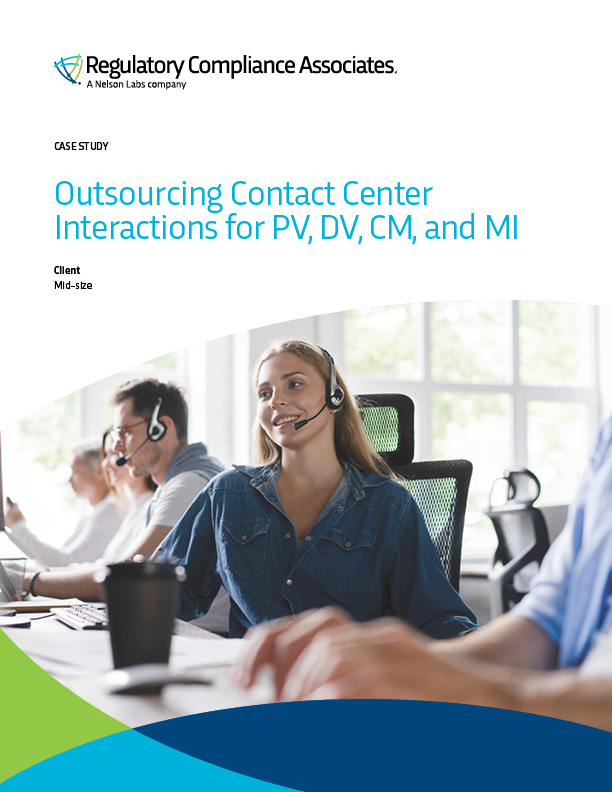Case Studies
Outsourcing Pharmacovigilence

Client
Mid-size in need of Contact Center support for Pharmacovigilance
Industry
Pharmaceutical and Medical Devices
Business Challenge
Develop a sustainable operational business model for PV, DV, CM, and MI that will meet increasing business demands and escalating regulatory requirements.
Project Timeline
Pharmacovigilance Pre-Implementation Due Diligence – 3 Months
Pharmacovigilance Pilot Site implementation (US Market) – 6 months
Pharmacovigilance Stabilization (US Market) – 6 months
Full Implementation with Staggered regional approach (EU, Asia, Australia New Zealand, South America, Canada) – 4 years
Client Challenge
A global pharmaceutical and medical device company faced challenges in scaling its workforce to meet the demands of rapid business growth and increasing regulatory oversight. Specifically, the company struggled to secure incremental staffing resources with the specialized expertise required for critical functions such as pharmacovigilance (PV), device vigilance (DV), complaint management (CM), and medical information (MI). Local resource shortages made it difficult to maintain compliance and operational efficiency across these high-impact areas.
RCA Approach
To address its resource challenges, the company partnered with Regulatory Compliance Associates® Inc. (RCA) to design and implement a cost-effective, scalable outsourcing model. This strategic solution was developed to accommodate current operational needs while remaining flexible for future changes in staffing and regulatory requirements. The approach centered on the following key elements:
- Strategic Resource Allocation: Lower-cost outsourced staff were engaged to manage repetitive, high-volume, low-complexity tasks, enabling internal high-value resources to concentrate on complex, high-risk activities with greater patient impact.
- Call Center Outsourcing: RCA helped transition call center operations for pharmacovigilance (PV), device vigilance (DV), complaint management (CM), and medical information (MI) to external providers, ensuring effective stakeholder engagement—including medical professionals, sales representatives, and consumers.
- Data Management Support: Internal information management systems were supplemented with outsourced data entry, quality monitoring, and case surveillance services to improve accuracy and throughput.
- Global Partner Identification: A Business Process Outsourcing Partner (BPOP) with a large global footprint was selected to provide offshore and outsourced call center capabilities, improving efficiency and reducing operational costs.
- End-to-End Process Support: Outsourced PV, DV, and CM functions included contact management, intake, triage, logistics, and categorization/prioritization of potential high-risk events (e.g., adverse events, product malfunctions) for escalation and regulatory reporting.
- Medical Information (MI) Support: Frontline customer service functions—such as call handling, case logging, and the delivery of verbal and written medical information—were successfully transitioned to outsourced resources.
- Retention of Critical Control: Throughout the process, the company maintained control over all critical decisions, including report ability assessments, product safety determinations, regulatory strategy, and risk management
Results
The business challenge was effectively resolved through the implementation of an outsourced and off-shored contact center model. This strategic shift yielded measurable improvements and long-term benefits across operational, financial, and regulatory areas. Key outcomes included:
- Significant Cost Savings: The new model led to a reduction in annual operational expenses by $1.3 million, representing a 16%savings on a functional annual spend of $8.0 million.
- Process Efficiency Gains: By leveraging the core competencies of the outsourcing partner, the company achieved key performance improvements that were unattainable with internal resources alone. Notably, the complaint registration cycle time was reduced from five days to same-day processing.
- Strategic Resource Allocation: High-cost internal resources were redirected to focus on critical decision-making activities by offloading repetitive, high-volume tasks.
- Established Strategic Growth Partner: The outsourcing partner became a reliable resource during business expansion, regulatory responses, recalls, and acquisitions—providing scalable support aligned with evolving business needs.
- Centralized Operations: The shift from a decentralized structure to a centralized contact center enabled streamlined operations, improved process oversight, and resource optimization at the regional level.
- Customer-Centric Flexibility: The model supported adaptation to evolving customer communication preferences (e.g., transitioning from phone to email-based intake).
- Enhanced Data Quality Oversight: With added quality surveillance processes in place, the company improved data integrity and content accuracy—capabilities that were previously unsustainable with internal staffing.
- Leadership Enablement: Functional leadership was freed to focus on process design, Voice of Customer initiatives, and critical regulatory strategy, rather than day-to-day transactional execution.
- Strengthened Regulatory Standing: The functional organization emerged as a strong point in regulatory audits by maintaining a clear focus on compliance, managing variability, and demonstrating continuous process improvement.
- Built-in Redundancy: The outsourced model provided built-in crisis resilience, including redundancy and backup operations during disruptions such as severe weather or system outages.
The outsourced and off-shored contact center model was recognized as a major success within the organization. It enabled access to high-caliber medical professionals, established a scalable and strategic partnership for future growth, and delivered substantial operational cost reductions. The implementation process was benchmarked as a best-in-class approach and now serves as a model for other functional areas within the company.




















